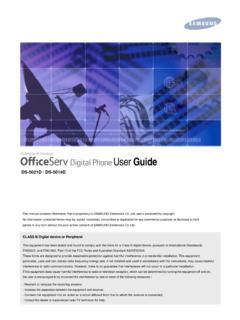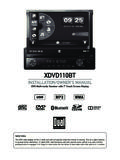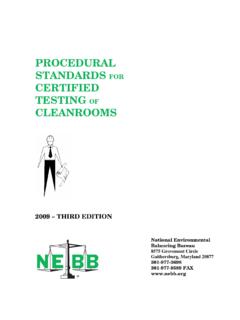Transcription of WHIRLPOOL & KITCHENAID IN-DOOR ICE SYSTEM
1 CONSUMER SERVICES TECHNICALEDUCATION GROUP PRESENTSR-92 JOB AIDPart No. 4322658 AWHIRLPOOL & KITCHENAIDIN-DOOR ICE SYSTEM - ii -FORWARDThis Job Aid, WHIRLPOOL & KITCHENAID IN-DOOR Ice SYSTEM , (Part No. 4322658A), provides thetechnician with information on the operation and service of the WHIRLPOOL & KITCHENAID In-DoorIce SYSTEM . It is to be used as a training Job Aid and Service Manual. For specific information onthe model being serviced, refer to the Use and Care Guide, or Tech Sheet provided with Wiring Diagrams used in this Job Aid are typical and should be used for training purposesonly. Always use the Wiring Diagram supplied with the product when servicing the AND OBJECTIVESThe goal of this Job Aid is to provide detailed information that will enable the service technician toproperly diagnose malfunctions and repair the IN-DOOR Ice objectives of this Job Aid are to: Understand and follow proper safety precautions.
2 Successfully troubleshoot and diagnose malfunctions. Successfully perform necessary repairs. Successfully return the IN-DOOR Ice SYSTEM to proper operational CORPORATION assumes no responsibility for any repairs madeon our products by anyone other than Authorized Service 2002, WHIRLPOOL Corporation, Benton Harbor, MI 49022- iii -TABLE OF OF The Ice Maker & The Water Fill The Emitter & Receiver & Reinstalling The The Selector Switch Pack & Dispenser & Diagnostics Diagnostics For Original Design Diagnostics For 2002 Design Diagnostics Diagnostics Mode Diagnostics Mode Chart A Original Optics Chart B 2002 Optics Chart C Component Diagnostics The DIAGRAMS & STRIP Wiring Wiring OF LEARNING iv - NOTES 1-1 This is the safety alert symbol alerts you to hazards that can kill or hurt you and safety messages will follow the safety alert symbol and either the word DANGER or WARNING.
3 These words mean:Electrical Shock HazardPlug into a grounded 3-prong not remove ground not use an not use an extension to follow these instructions canresult in death, fire, or electrical Shock HazardDisconnect power before all panels before to do so can result in death orelectrical FIRSTYour safety and the safety of others is very have provided many important safety messages in this Job Aid and on the appliance. Alwaysread and obey all safety safety messages will tell you what the potential hazard is, tell you how to reduce the chanceof injury, and tell you what can happen if the instructions are not can be killed or seriously injured if you don timmediately follow can be killed or seriously injured if you don tfollow POWER SUPPLY &GROUNDING REQUIREMENTSWARNINGWARNING1-2 Electrical Shock HazardConnect green ground wire to to do so can result in death orelectrical Discharge (ESD)Sensitive ElectronicsESD problems are present may damage or weaken the elec-tronic control assembly.
4 The new controlassembly may appear to work well afterrepair is finished, but failure may occur ata later date due to ESD stress. Use an antistatic wrist strap. Connect thewrist strap to the green ground connec-tion point, or to an unpainted metal sur-face in the OR - Touch your finger repeatedly to a greenground connection point, or to an un-painted metal surface in the appliance. Before removing the part from its pack-age, touch the antistatic bag to a greenground connection point, or to an un-painted metal surface in the appliance. Avoid touching electronic parts, or termi-nal contacts. Handle the electronic con-trol assembly by the edges only. When repackaging the failed electroniccontrol assembly in an antistatic bag,observe the previous INTRODUCTIONOVERVIEWThe primary objective of the IN-DOOR Ice Sys-tem is to increase the usable space in thefreezer compartment of the current freestand-ing side-by-side refrigerator/freezer.
5 The solu-tion is to relocate the ice maker, the ice con-tainer, and drive mechanism, and replace thiseye-level volume with a cantilever shelving sys-tem. The following description is intended torelate the changes that have been made fromthe current side-by-side ice & water dispenserconfiguration. The description is divided intothree categories: Ice Making, Ice Storage, &Ice MAKINGThe ice maker module and mold have not beenchanged from the current models. However,the location, mounting method, air delivery,water delivery, ice stripper, and ice level shutoffhave all been & MountingThe ice maker has been relocated to the topfront of the freezer liner, and has been rotated90 . Due to code requirements, the ice makerheater area is now protected by a plastic (PVC)mounting bracket. The bracket is attached tothe ice maker with three mounting screws, andis held in place by grooved tracks on eitherside of the freezer (1 of 3)Air DeliveryAir is delivered to the ice maker mold througha duct.
6 This duct hooks onto the rear air ductat the back of the liner, and is secured to thetop of the liner with two screws. The duct di-rects approximately 50% of the freezer air for-ward to the ice maker mold. The mountingbracket, mentioned in the previous section,also serves as an air director, and directs theair that is delivered by the duct, under the mold,and allows it to escape just under the ice Duct2-2 The water tube is made of polypropylene withan overmolded santoprene nozzle. Due to therigid nature of the polypropylene, this tube ismated to a more flexible polyethylene tube witha John Guest fitting high on the back change of material is necessary to pre-vent kinking when the tubing is attached to thewater DeliveryWater is delivered to the ice maker mold bymeans of a tube-within-a-tube design. A con-duit SYSTEM consisting of three separate pieces(liner fitting, conduit, back panel fitting) isfoamed into place in the conduit provides a pathway from thefreezer liner to the back panel.
7 The majority ofthis SYSTEM is routed above the refrigerator linerto prevent the water tubing from freezing. Thetubing that delivers the water is routed throughthe conduit, and is secured by snapping intoplace at the freezer liner fitting. Back Panel FittingJohnGuestFittingWaterTubeWater Nozzle2-3 Ice StripperThe ice stripper has been modified in order todirect ice into the new ice container. The maindifferences from the current stripper are: anincreased ramp, and a directing wall at the fillcup Level ShutoffThe mechanical shutoff arm on the older icemakers has been replaced with an electronicice level control SYSTEM . This SYSTEM is locatedon either side of the freezer liner and utilizesinfrared light technology to sense the level ofice in the door-mounted ice container. A manualshutoff option is still available on the right sideof the freezer liner. This feature consists of aplastic slide that covers the receiver sensor andblocks the infrared EmitterEjector BladesIce Stripper & RampInfraredReceiverManualShutoffStatus LED5-Cavity Ice Maker For22 Cu.
8 Ft. Models2-4 ICE STORAGEThe ice container has been redesigned andrelocated to the freezer door. It is secured inplace on the door liner with a sliding spring-loaded latch, mounted to a plate with two mounting plate is foamed-in-place on thedoor. The ice container is easily removed andreplaced on the door regardless of the ice container is removed by pressing arelease button on the right side and instructions are printed on the changes to the ice container consist ofa vertical rod ice auger, and a clear polycar-bonate upper section. The vertical orientationof the bin helps prevent stale ice areas, be-cause the ice is a first in first out systemwhich helps keep the ice fresher. Also, the icecontainer can be completely DISPENSINGM ajor changes have been made to the powertrain. The motor has been redesigned and re-located to the freezer door. The cube/crushselector solenoid and its related linkage havebeen eliminated, and a drive shaft/spring-loaded coupling have been motor is now located on the freezer doorin a foamed-in-place enclosure under the dis-penser bubble area of the inner door motor is mounted to a plastic mountingbracket, which, in turn, is mounted to the en-closure with four mounting motor operates on 115 volts DC (115 voltsAC is delivered to the motor, where it is con-verted within the motor assembly to DC).
9 Thisgives the motor a higher RPM than the earlierdispenser motors, and results in a faster icedelivery rate in both the cubed and ice is delivered by turning the motorin a clockwise direction, and cubed ice is de-livered when the motor turns in a counterclock-wise PlateAuger Coupling IceContainerReleaseButton IceAugerMotor2-5 Drive Shaft / CouplingThe drive shaft / coupling connects the motorto the ice container auger. The coupling at thetop of the motor drive shaft is spring-loaded toallow replacing the ice container without hav-ing to orient its coupling with the motor driveshaft coupling. If the two couplings do not en-MotorHex Drive Shaftgage when the container is placed on the door,the motor drive shaft coupling will be de-pressed. The next time ice is dispensed, themotor drive shaft coupling will spring up, andengage the ice container original designed units use a pin that restson a spring, located inside the drive shaft.
10 Thenewly designed units have only the spring,which rests in a shallower opening at the topof the drive shaft, and eliminates the need forthe newly designed models, the hex drive shaftcoupling has a skirt around it to prevent anypieces of a damaged coupling from falling downthe of Original DesignHex Drive ShaftSpring-Loaded PinOriginal Hex DriveShaft CouplingNewly DesignedHex Drive ShaftCoupling SkirtTop of Newly DesignedHex Drive ShaftSpring2-6 NOTES 3-1 THEORY OF OPERATIONThe ice maker loads, the motor, heater, andwater valve, are still controlled by the stampedcircuit module, which is part of the ice electronic control will check periodicallyto see if the ice maker is at the home position,(when the ejector stops at the 2 o clock posi-tion). If the ejector is at the home position, therelay will deenergize, and remove power fromthe ice maker until the next improve functionality and reliability, someimportant differences exist between the newIn-Door Ice SYSTEM , and the earlier mechani-cal-type ice making first is that a harvest can only begin if thefreezer door is closed, and previous harvestconditions are also met (ejector at home).





